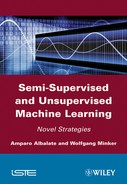Table of Contents
1.3. Datasets from the UCI repository
Chapter 2. State of the Art in Clustering and Semi-Supervised Techniques
2.2. Unsupervised machine learning (clustering)
2.3. A brief history of cluster analysis
2.5. Applications of cluster analysis
2.7. Internal cluster evaluation
2.8. External cluster validation
Part 2. Approaches to Semi-Supervised Classification
Chapter 3. Semi-Supervised Classification Using Prior Word Clustering
3.3. Utterance classification scheme
3.4. Semi-supervised approach based on term clustering
Chapter 4. Semi-Supervised Classification Using Pattern Clustering
4.2. New semi-supervised algorithm using the cluster and label strategy
4.4. Supervised classification block
4.6. An analysis of the bounds for the cluster and label approaches
4.7. Extension through cluster pruning
Chapter 5. Detection of the Number of Clusters through Non-Parametric Clustering Algorithms
5.2. New hierarchical pole-based clustering algorithm
Chapter 6. Detecting the Number of Clusters through Cluster Validation
6.2. Cluster validation methods
6.3. Combination approach based on quantiles
